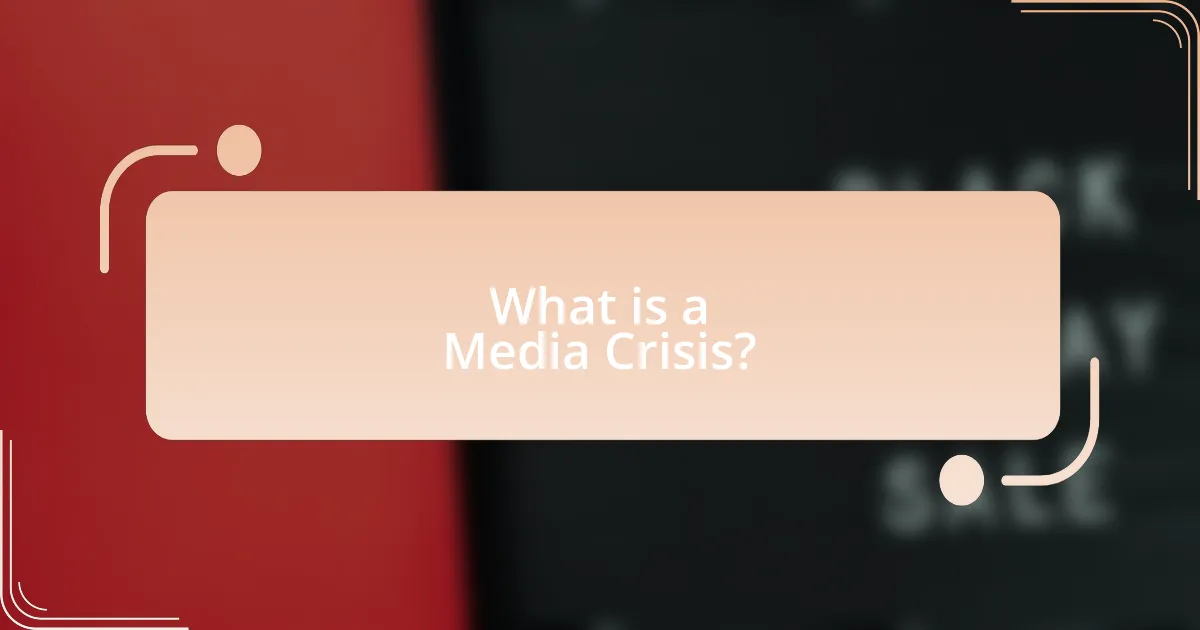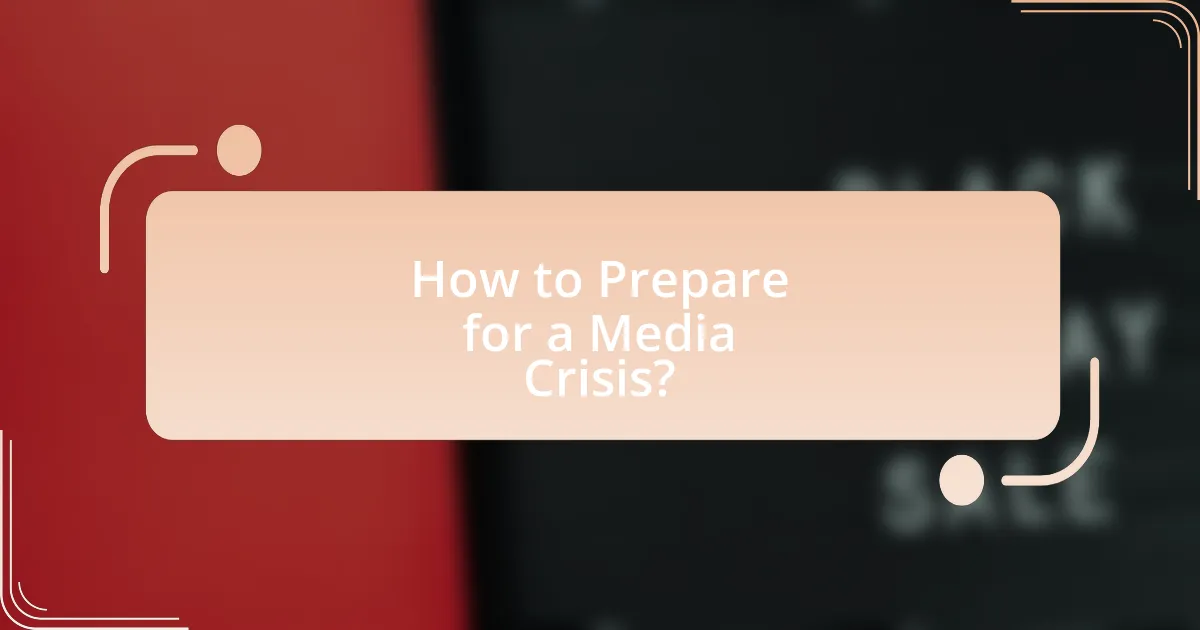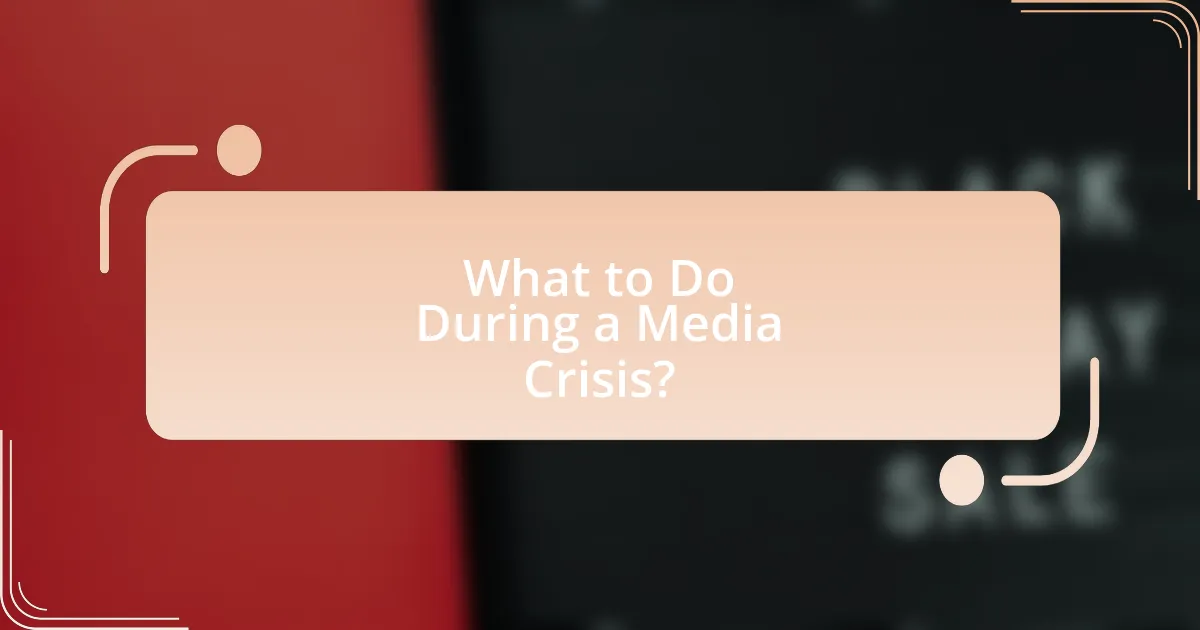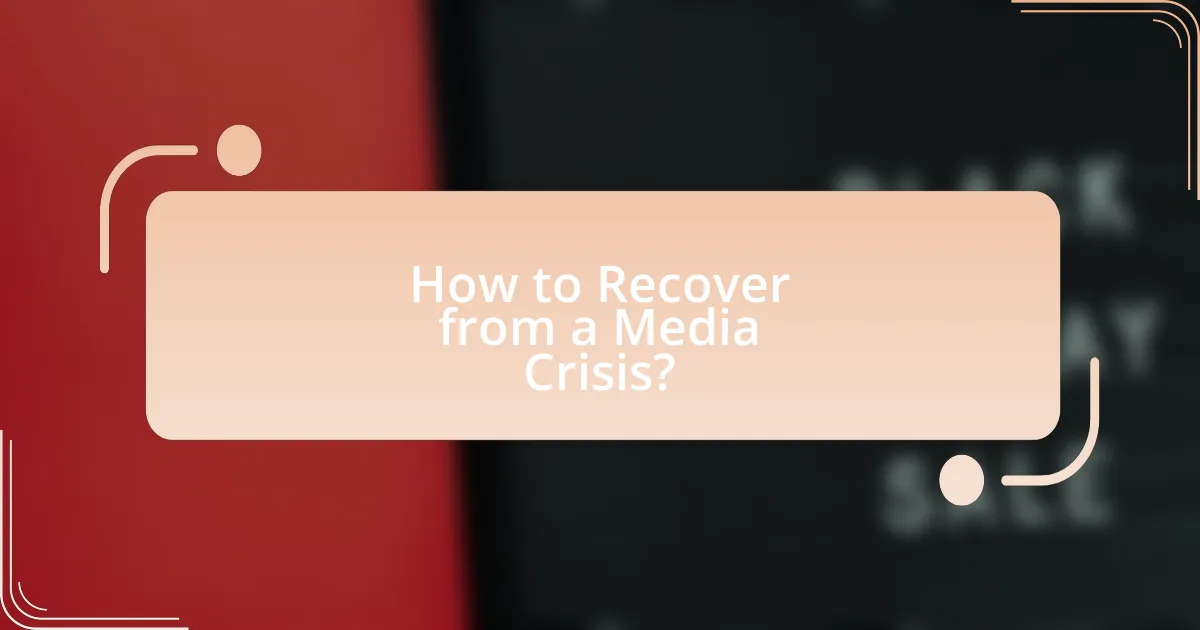A media crisis is a situation where an organization faces negative publicity that threatens its reputation and operations, often stemming from scandals, product failures, or unethical behavior. The article outlines the significant impacts of media crises on organizations, including damage to reputation, loss of customer trust, and financial instability. It emphasizes the importance of having a crisis management plan, which includes elements such as communication strategies, risk assessments, and designated crisis management teams. Additionally, the article discusses how to prepare for, respond to, and recover from media crises, highlighting the necessity of transparency, effective communication, and ongoing training to mitigate risks and rebuild reputation.

What is a Media Crisis?
A media crisis is a situation where an organization faces negative publicity that threatens its reputation and operations. This can arise from various incidents, such as scandals, product failures, or unethical behavior, which attract significant media attention and public scrutiny. For example, the 2017 United Airlines incident, where a passenger was forcibly removed from an overbooked flight, led to widespread media coverage and public outrage, severely impacting the airline’s brand image.
How can a media crisis impact an organization?
A media crisis can severely impact an organization by damaging its reputation, leading to loss of customer trust and financial instability. For instance, a study by the Institute for Public Relations found that 70% of organizations experience a decline in customer loyalty following a media crisis. Additionally, negative media coverage can result in decreased stock prices; for example, when United Airlines faced backlash over a passenger removal incident in 2017, its stock dropped by 4% within days. This illustrates that the repercussions of a media crisis can be both immediate and long-lasting, affecting various aspects of an organization’s operations and stakeholder relationships.
What are the common causes of media crises?
Common causes of media crises include misinformation, negative publicity, and organizational mismanagement. Misinformation can arise from inaccurate reporting or social media rumors, leading to public distrust and backlash. Negative publicity often stems from scandals or unethical behavior, which can quickly escalate in the digital age. Organizational mismanagement, such as poor communication strategies or failure to address issues proactively, can exacerbate crises and damage reputations. These factors are supported by numerous case studies, including the 2017 United Airlines incident, where mishandling of a passenger situation led to widespread outrage and significant brand damage.
How do media crises affect public perception?
Media crises significantly alter public perception by amplifying negative sentiments and distrust towards the involved entities. During a media crisis, information dissemination often accelerates, leading to rapid public reactions that can be based on incomplete or biased narratives. For instance, a study by the Pew Research Center found that 63% of Americans believe that news organizations often report news inaccurately, which can exacerbate skepticism during crises. This heightened scrutiny can result in long-term reputational damage, as public opinion is shaped by the prevailing narratives that emerge during such events.
Why is it important to have a crisis management plan?
A crisis management plan is important because it provides a structured approach to addressing unexpected events that could harm an organization’s reputation or operations. Having a plan in place allows organizations to respond quickly and effectively, minimizing damage and ensuring continuity. Research indicates that companies with crisis management plans are 50% more likely to recover from a crisis without significant long-term impact, as they can implement predefined strategies and communication protocols. This preparedness not only protects the organization but also helps maintain stakeholder trust during turbulent times.
What elements should be included in a crisis management plan?
A crisis management plan should include the following elements: a clear definition of the crisis, a communication strategy, a designated crisis management team, risk assessment procedures, response protocols, and a recovery plan. Each element plays a crucial role in effectively managing a crisis. For instance, a clear definition of the crisis helps in understanding the scope and impact, while a communication strategy ensures that accurate information is disseminated to stakeholders. The designation of a crisis management team allows for organized leadership during the crisis, and risk assessment procedures identify potential vulnerabilities. Response protocols outline specific actions to be taken, and a recovery plan focuses on restoring normal operations post-crisis. These components are essential for minimizing damage and ensuring a swift recovery, as evidenced by successful crisis management cases in various organizations.
How can a crisis management plan mitigate risks?
A crisis management plan mitigates risks by providing a structured approach to identifying, assessing, and responding to potential crises. This plan enables organizations to prepare for adverse events, thereby minimizing the impact on operations, reputation, and stakeholder trust. For instance, research by the Institute for Crisis Management indicates that organizations with a crisis management plan are 50% more likely to recover quickly from a crisis compared to those without one. By outlining clear communication strategies and designated roles, a crisis management plan ensures timely and effective responses, reducing confusion and enhancing decision-making during critical situations.

How to Prepare for a Media Crisis?
To prepare for a media crisis, organizations must develop a comprehensive crisis communication plan that includes identifying potential risks, establishing a crisis management team, and creating key messages. A well-defined plan allows for swift and effective responses, minimizing damage to reputation. Research indicates that 70% of organizations without a crisis plan experience greater reputational harm during a crisis, highlighting the importance of preparation. Regular training and simulations for the crisis management team ensure readiness and adaptability in real situations.
What steps should be taken to identify potential media crises?
To identify potential media crises, organizations should conduct regular risk assessments, monitor social media and news outlets, and analyze stakeholder sentiment. Risk assessments help pinpoint vulnerabilities that could lead to crises, while monitoring social media and news outlets allows organizations to detect emerging issues in real-time. Analyzing stakeholder sentiment provides insights into public perception and potential backlash. For instance, a study by the Pew Research Center found that 64% of Americans believe social media has a significant impact on public opinion, highlighting the importance of monitoring these platforms for early warning signs of a crisis.
How can organizations conduct a risk assessment?
Organizations can conduct a risk assessment by systematically identifying, analyzing, and evaluating potential risks that could impact their operations. This process typically involves several key steps: first, organizations should identify risks through brainstorming sessions, surveys, and historical data analysis. Next, they analyze the likelihood and impact of each identified risk using qualitative or quantitative methods. Following this, organizations prioritize the risks based on their potential effect on business objectives. Finally, they develop and implement strategies to mitigate the highest-priority risks, ensuring continuous monitoring and review of the risk environment. This structured approach is supported by frameworks such as ISO 31000, which provides guidelines for effective risk management practices.
What role does monitoring play in crisis preparedness?
Monitoring plays a critical role in crisis preparedness by enabling organizations to identify potential threats and assess their impact in real-time. Effective monitoring allows for the early detection of emerging issues, facilitating timely responses that can mitigate damage. For instance, organizations that utilize social media monitoring tools can track public sentiment and identify negative trends before they escalate into full-blown crises. Research indicates that companies with robust monitoring systems are 50% more likely to respond effectively to crises, as they can gather actionable insights and adjust their strategies accordingly.
How can training help in crisis management?
Training enhances crisis management by equipping individuals with the skills and knowledge necessary to respond effectively under pressure. It prepares teams to identify potential crises, develop response strategies, and communicate clearly with stakeholders. For instance, organizations that implement crisis management training programs report a 30% improvement in response times during actual crises, as evidenced by a study conducted by the Institute for Crisis Management. This training fosters confidence, promotes teamwork, and ensures that all members understand their roles, ultimately leading to more effective crisis resolution.
What types of training should be provided to staff?
Staff should receive training in crisis communication, media relations, and social media management. Crisis communication training equips employees with the skills to convey clear and accurate messages during a media crisis, ensuring that the organization’s response is timely and effective. Media relations training focuses on building relationships with journalists and understanding how to interact with the media, which is crucial during a crisis. Social media management training is essential for monitoring online conversations and responding appropriately to public inquiries or misinformation. These training types are supported by research indicating that organizations with well-trained staff are better prepared to manage crises effectively, minimizing reputational damage and maintaining public trust.
How often should crisis management training be conducted?
Crisis management training should be conducted at least annually. Regular training ensures that team members are familiar with updated protocols and can effectively respond to evolving crisis scenarios. According to a study by the International Association of Business Communicators, organizations that conduct annual crisis management training are 30% more effective in managing crises compared to those that do not. This frequency allows for the integration of lessons learned from past incidents and keeps the team prepared for potential future crises.

What to Do During a Media Crisis?
During a media crisis, the primary action is to establish clear communication. Organizations should promptly assess the situation, gather accurate information, and designate a spokesperson to convey messages consistently. This approach minimizes misinformation and maintains public trust. For instance, during the 2010 BP oil spill, the company faced backlash due to delayed responses and unclear messaging, which exacerbated the crisis. Effective communication strategies, such as timely press releases and social media updates, can significantly mitigate negative impacts and help regain control of the narrative.
How should organizations respond to a media crisis?
Organizations should respond to a media crisis by implementing a structured communication strategy that includes immediate acknowledgment of the issue, transparent information sharing, and a clear plan for resolution. This approach is essential as it helps to mitigate damage to reputation and maintain public trust. For instance, during the 2017 United Airlines incident, the company faced significant backlash due to its initial lack of response; however, once it acknowledged the situation and communicated its actions, it began to regain customer confidence. Effective crisis management involves designating a spokesperson, monitoring media coverage, and engaging with stakeholders to provide updates, which collectively contribute to a more controlled narrative and reduced speculation.
What are the key components of an effective response strategy?
The key components of an effective response strategy include clear communication, timely information dissemination, and stakeholder engagement. Clear communication ensures that the message is concise and understandable, which is crucial during a media crisis. Timely information dissemination allows organizations to control the narrative and reduce speculation, as seen in the case of Johnson & Johnson during the Tylenol crisis in 1982, where prompt action helped maintain public trust. Stakeholder engagement involves actively involving affected parties, such as employees and customers, to foster transparency and accountability. These components collectively enhance the effectiveness of a response strategy in managing media crises.
How can transparency be maintained during a crisis?
Transparency can be maintained during a crisis by providing timely and accurate information to stakeholders. Organizations should establish a clear communication plan that includes regular updates, designated spokespersons, and accessible channels for information dissemination. For instance, during the COVID-19 pandemic, health organizations like the World Health Organization consistently shared data and guidelines, which helped build public trust and compliance. This approach demonstrates that transparency not only involves sharing information but also ensuring that it is reliable and easily understood by the audience.
What communication channels should be utilized?
Utilize social media, press releases, email, and direct communication as key communication channels during a media crisis. Social media platforms like Twitter and Facebook allow for real-time updates and engagement with the audience, which is crucial for managing public perception. Press releases provide formal statements to the media, ensuring accurate information dissemination. Email serves as a direct line to stakeholders and internal teams, facilitating clear communication. Direct communication, such as phone calls or meetings, can address specific concerns and maintain relationships. These channels are effective because they enable timely responses and control over the messaging, which is essential in crisis management.
How can social media be effectively used during a crisis?
Social media can be effectively used during a crisis by providing timely updates, facilitating communication, and engaging with the public. During crises, organizations can utilize platforms like Twitter and Facebook to disseminate real-time information, which is crucial for public safety and awareness. For instance, during the 2014 Ebola outbreak, the World Health Organization used social media to share vital health information and counter misinformation, reaching millions quickly. Additionally, social media allows organizations to interact directly with the public, addressing concerns and questions, which fosters trust and transparency. This direct engagement was evident during the COVID-19 pandemic, where health authorities used social media to clarify guidelines and combat misinformation effectively.
What role do press releases play in crisis communication?
Press releases serve as a critical tool in crisis communication by providing timely and accurate information to the media and the public. They help organizations control the narrative during a crisis, ensuring that the official message is disseminated quickly to counter misinformation. For instance, during the 2010 BP oil spill, the company issued multiple press releases to address concerns, clarify actions taken, and outline recovery efforts, which helped manage public perception and media coverage. This demonstrates that effective press releases can mitigate reputational damage and maintain stakeholder trust during challenging situations.

How to Recover from a Media Crisis?
To recover from a media crisis, organizations must first acknowledge the issue transparently and communicate openly with stakeholders. This involves issuing a public statement that addresses the crisis, clarifies the organization’s position, and outlines steps being taken to resolve the situation. Research indicates that transparency can significantly mitigate reputational damage; for instance, a study by the Institute for Public Relations found that organizations that communicate openly during a crisis can restore public trust more effectively. Following this, organizations should implement a strategic response plan that includes monitoring media coverage, engaging with affected parties, and providing regular updates to maintain stakeholder confidence.
What steps are necessary for post-crisis evaluation?
The necessary steps for post-crisis evaluation include assessing the response effectiveness, gathering feedback from stakeholders, analyzing media coverage, and identifying lessons learned. Assessing response effectiveness involves reviewing the actions taken during the crisis to determine what worked and what did not. Gathering feedback from stakeholders, such as employees, customers, and partners, provides insights into their perceptions and experiences during the crisis. Analyzing media coverage helps to understand public sentiment and the narrative presented by the media. Identifying lessons learned is crucial for improving future crisis management strategies and ensuring that similar issues are handled more effectively. These steps collectively contribute to a comprehensive evaluation that enhances organizational resilience.
How can organizations assess the impact of the crisis?
Organizations can assess the impact of a crisis by conducting a comprehensive analysis of key performance indicators (KPIs) and stakeholder feedback. This involves measuring changes in customer sentiment, brand reputation, and financial performance before, during, and after the crisis. For instance, a study by the Institute for Public Relations found that organizations that actively monitor social media sentiment can gauge public perception and adjust their communication strategies accordingly. Additionally, surveys and focus groups can provide qualitative insights into stakeholder attitudes, helping organizations understand the crisis’s broader implications.
What strategies can be implemented for reputation rebuilding?
To rebuild reputation, organizations should implement strategies such as transparent communication, proactive engagement with stakeholders, and consistent delivery of positive messaging. Transparent communication involves openly addressing the issues that led to the reputational damage, which fosters trust and credibility. Proactive engagement with stakeholders, including customers, employees, and the media, allows organizations to listen to concerns and demonstrate commitment to improvement. Consistent delivery of positive messaging through various channels, such as social media and press releases, helps to reshape public perception over time. Research indicates that companies that effectively communicate during crises can recover their reputations more swiftly, as seen in the case of Johnson & Johnson during the Tylenol crisis in the 1980s, where their transparent approach led to a swift recovery in consumer trust.
What lessons can be learned from a media crisis?
A media crisis teaches the importance of timely and transparent communication. Organizations must respond quickly to misinformation to maintain credibility, as seen in the case of the 2017 United Airlines incident, where delayed responses exacerbated public outrage. Additionally, a media crisis highlights the necessity of having a crisis management plan in place, which can mitigate damage and guide effective responses. Research indicates that companies with established crisis communication strategies recover faster and retain customer trust, underscoring the value of preparedness in navigating media challenges.
How can organizations improve their crisis management plans based on past experiences?
Organizations can improve their crisis management plans by conducting thorough post-crisis evaluations to identify strengths and weaknesses in their response strategies. Analyzing past crises allows organizations to pinpoint specific areas for enhancement, such as communication protocols, resource allocation, and stakeholder engagement. For instance, a study by the Harvard Business Review highlighted that companies that regularly review and update their crisis plans based on previous incidents are 30% more effective in managing future crises. By integrating lessons learned into training programs and simulations, organizations can ensure that their teams are better prepared for similar situations in the future.
What are the best practices for future crisis prevention?
The best practices for future crisis prevention include establishing a proactive communication strategy, conducting regular risk assessments, and training staff on crisis management protocols. Proactive communication strategies ensure that organizations can disseminate accurate information quickly, reducing misinformation during a crisis. Regular risk assessments help identify potential vulnerabilities, allowing organizations to address them before they escalate. Training staff on crisis management protocols equips them with the necessary skills to respond effectively, minimizing the impact of any crisis. These practices are supported by research indicating that organizations with robust crisis management plans experience less reputational damage and recover more quickly from adverse events.
What are the common pitfalls to avoid during a media crisis?
Common pitfalls to avoid during a media crisis include failing to communicate promptly, which can lead to misinformation and speculation. Organizations should ensure timely and transparent communication to maintain trust. Another pitfall is not having a designated spokesperson, which can result in mixed messages and confusion. Additionally, ignoring social media can exacerbate the situation, as it is often the primary platform for public discourse. Lastly, underestimating the impact of the crisis can lead to inadequate responses, as seen in cases like the 2010 BP oil spill, where delayed action worsened public perception and trust.
How can misinformation be addressed effectively?
Misinformation can be addressed effectively through a combination of fact-checking, transparent communication, and public education. Fact-checking organizations, such as Snopes and FactCheck.org, play a crucial role in verifying claims and providing accurate information to counter false narratives. Transparent communication from credible sources, including government agencies and reputable media outlets, helps to clarify misunderstandings and provide context. Public education initiatives that promote media literacy empower individuals to critically evaluate information sources, reducing the spread of misinformation. Research indicates that media literacy programs can significantly improve individuals’ ability to discern credible information, thereby mitigating the impact of misinformation in society.
What mistakes should organizations avoid in their communication?
Organizations should avoid ambiguity in their communication. Clear and concise messaging is essential to prevent misunderstandings and misinformation during media crises. For instance, a study by the Institute for Public Relations found that organizations that provide specific information during a crisis are perceived as more trustworthy, leading to better public relations outcomes. Additionally, organizations must refrain from delaying responses, as timely communication can mitigate damage and maintain public trust. According to research from the Harvard Business Review, rapid responses can significantly reduce negative perceptions during crises. Lastly, organizations should avoid using jargon or overly technical language, as this can alienate audiences and obscure the message. Clear language fosters better understanding and engagement with stakeholders.
What practical tips can help in handling media crises effectively?
To handle media crises effectively, organizations should establish a clear communication plan that includes timely and transparent messaging. This approach ensures that stakeholders receive accurate information promptly, which can mitigate misinformation and maintain trust. For instance, during the 2010 BP oil spill, the company faced backlash due to delayed responses and unclear messaging, highlighting the importance of proactive communication in crisis management. Additionally, appointing a designated spokesperson can streamline communication efforts and provide a consistent voice, further enhancing credibility during a crisis.